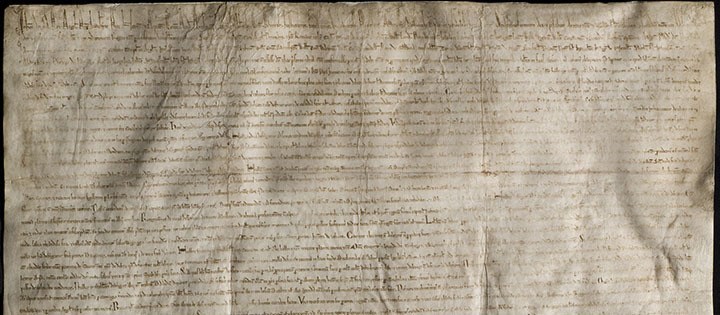Eight-hundred-year-old documents are not the usual bailiwick of this blog. On Friday, however, I had the great privilege of attending an event at the Supreme Court for the release of the book, Magna Carta: Muse & Mentor. What I learned is that the story of Magna Carta’s origins and impact is far more complex than my rudimentary knowledge of it had assumed.
 The book is a companion to the eponymous exhibit that opened at the Library of Congress Nov. 6. The opening, by all accounts, was a grand affair surrounded by various events and kicked off by a ribbon cutting attended by British royalty, Princess Anne. The exhibit features the 1215 Lincoln Cathedral Magna Carta, one of only four surviving copies of the original 1215 Magna Carta.
The book is a companion to the eponymous exhibit that opened at the Library of Congress Nov. 6. The opening, by all accounts, was a grand affair surrounded by various events and kicked off by a ribbon cutting attended by British royalty, Princess Anne. The exhibit features the 1215 Lincoln Cathedral Magna Carta, one of only four surviving copies of the original 1215 Magna Carta.
The book, co-published by Thomson Reuters and the Library of Congress, presents the 80 images from the exhibit together with scholarly essays about the history and significance of Magna Carta. The book was edited by Delaware Supreme Court Justice Randy J. Holland and features essays from such authors as retired Supreme Court Justice Sandra Day O’Connor; retired Lord Chief Justice of England and Wales Igor Judge; and Magna Carta in pop culture contributor and historian Carolyn Harris.
The book is beautifully printed, with full-color illustrations throughout. As for the essays, I’ve only skimmed them so far, but three of the authors spoke on a panel at Friday’s Supreme Court event and whet my appetite to read more. The panel’s four speakers — Lord Judge; Lord Justice Stephen Tomlinson of the UK Court of Appeal (who was not an author); A.E. Dick Howard, Magna Carta scholar and professor of law at the University of Virginia; and lexicographer Bryan A. Garner — underscored the extent to which Magna Carta forms the foundation of the most important principles of American law, including due process, habeas corpus, and the right to trial by jury.
In his introduction to the book, Librarian of Congress David S. Mao writes:
It is remarkable … that in the twenty-first century people continue to admire a medieval charter that is not law in any world jurisdiction, and that contains provisions relating generally to customs and institutions that have not existed anywhere for hundreds of years.
As for why that is so, this book and the LOC exhibit offer many insights. This book is sold for $69 and is available in print and as an ebook from Thomson Reuters or at the Library of Congress gift shop. The LOC exhibit runs through Jan. 19, 2015.
 Robert Ambrogi Blog
Robert Ambrogi Blog